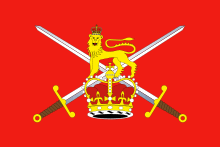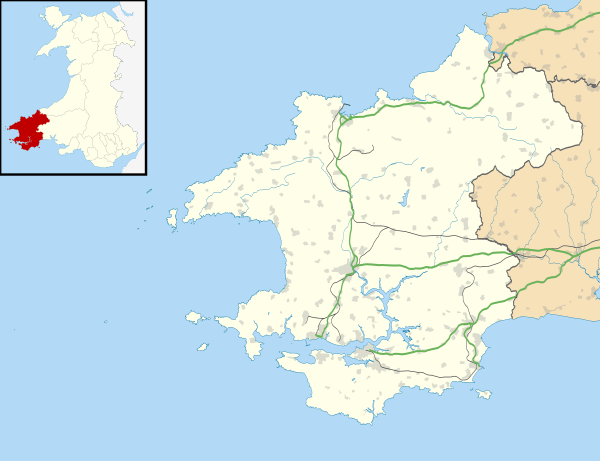Cawdor Barracks
| Cawdor Barracks RNAS Brawdy HMS Goldcrest  | |||||||||
|---|---|---|---|---|---|---|---|---|---|
| Near Brawdy, Pembrokeshire in Wales | |||||||||
|
Cawdor Barracks | |||||||||
 Cawdor Barracks Shown within Pembrokeshire | |||||||||
| Coordinates | 51°53′01″N 005°07′26″W / 51.88361°N 5.12389°WCoordinates: 51°53′01″N 005°07′26″W / 51.88361°N 5.12389°W | ||||||||
| Type | Barracks | ||||||||
| Site information | |||||||||
| Owner | Ministry of Defence | ||||||||
| Operator | British Army | ||||||||
| Controlled by | 14th Signal Regiment | ||||||||
| Site history | |||||||||
| Built | 1944 | ||||||||
| In use |
1944-1992 1992-present | ||||||||
| Battles/wars |
Second World War Cold War | ||||||||
| Airfield information | |||||||||
| Elevation | 111 metres (364 ft) AMSL | ||||||||
| |||||||||
| |||||||||
Cawdor Barracks is a military installation located 6.3 miles (10.1 km) east of St Davids, Pembrokeshire and 9.8 miles (15.8 km) south west of Fishguard, Pembrokeshire, Wales.
It was an operational airbase between 1944 and 1992 being used by both the Royal Air Force and the Royal Navy before the site was turned over to the British Army and renamed Cawdor Barracks.
History
The Pembrokeshire base was officially opened on 2 February 1944 as a satellite station for the nearby RAF St Davids with No. 517 Squadron RAF moving in a day before with the Handley Page Halifax Mk V before changing to the Mk III in March 1945. The squadron moved to RAF Chivenor on 30 November 1945.[1] The next squadron to move in was 521 Squadron from December 1944 until May 1945 as a detachment operating the Boeing Fortress II.[2] Between 2 February 1944 and 27 April 1946 595 Squadron aircraft may have been based here with a variety of aircraft as a detachment.[3]
Fleet Air Arm use
On 1 January 1946 the station was handed over to the Fleet Air Arm of the Royal Navy and was initially used as a Relief Landing Ground for RNAS Dale. It was commissioned as HMS Goldcrest on 4 September 1952 and in March 1953 the first Hawker Sea Hawk entered service with 806 Naval Air Squadron at RNAS Brawdy. From 1963 till 1971 Fairey Gannets and Hawker Hunters were based at Brawdy in 849 NAS and 738/759 NAS respectively. The Gannets were primarily used in Airborne Early Warning (AEW) and the Hunters for advanced flying training including low-level navigation, ground attack and air-to-air weapons training. The Royal Navy left in 1971 and the base was allocated to the Department of the Environment.[4]

The following squadrons were also here at some point:[5]
- 727 Naval Air Squadron
- 736 Naval Air Squadron
- 751 Naval Air Squadron
- 767 Naval Air Squadron
- 773 Naval Air Squadron
- 784 Naval Air Squadron
- 800 Naval Air Squadron
- 801 Naval Air Squadron
- 802 Naval Air Squadron
- 804 Naval Air Squadron
- 807 Naval Air Squadron
- 811 Naval Air Squadron
- 813 Naval Air Squadron
- 824 Naval Air Squadron
- 831 Naval Air Squadron
- 891 Naval Air Squadron
- 892 Naval Air Squadron
- 893 Naval Air Squadron
- 895 Naval Air Squadron
- 897 Naval Air Squadron
- 898 Naval Air Squadron
- 1831 Naval Air Squadron
RAF Brawdy
In February 1974 the Royal Air Force returned to RAF Brawdy with D Flight of 22 Squadron taking up residence with their Westland Whirlwind HAR.10 search and rescue helicopters.[6] In September of the same year No. 229 Operational Conversion Unit, later the Tactical Weapons Unit (TWU), joined D Flt 22 Sqn having been forced to relocate after the closure of RAF Chivenor.[4]
The station was home to Hawker Hunter aircraft of the TWU. The gate guardian at the base was initially a Supermarine Spitfire, but this was replaced in the early 80s by Hawker Hunter FGA.9 (XE624). This airframe was subsequently sold to Steve Petch, a private collector.[7]
Between 1 September 1976 and July 1978 a detachment of 202 Sqn flying Whirlwind HAR.10s used the airfield.[8]
By the late 1970s TWU operated BAE Systems Hawk T.1As of 234 Sqn and 79 Sqn Squadron.[4] The RAF withdrew in 1992, the airbase was transferred to the Army and renamed Cawdor Barracks.[4]
Army Barracks
The barracks were established, on the site of the former RAF Brawdy airfield, in 1995.[9] They took their name from the local earls of Cawdor (who owned the Stackpole Estate) and the site became the main electronic warfare base of the British Army.[4] As such the barracks became home to the 14th Signal Regiment ("14 Signals"), the British Army's electronic warfare unit.[10] The Regiment remains on site and has a HQ squadron[11] and five signal squadrons, one of which is based at RAF Digby:[12]
- 14th Signal Regiment (Electronic Warfare)
- Operations Support Squadron
- 223 Signal Squadron (Electronic Warfare)
- 226 Signal Squadron (Electronic Warfare)
- 237 Signal Squadron (Electronic Warfare)
- 245 Signal Squadron (Electronic Warfare)
In November 2016 the Ministry of Defence announced that the site would close in 2024.[13]
References
Citations
- ↑ Jefford 2001, p. 95.
- ↑ Jefford 2001, p. 96.
- ↑ Jefford 2001, p. 97.
- 1 2 3 4 5 "RAF Brawdy". Forces War Records. Retrieved 30 March 2014.
- ↑ "Brawdy". Airfields of Britain Conservation Trust. Retrieved 10 March 2015.
- ↑ Jefford 2001, p. 32.
- ↑ "Cold War Jets Collection". Retrieved 31 January 2007.
- ↑ Jefford 2001, p. 68.
- ↑ "14 Regiment Royal Signals". British Army units 1945 on. Retrieved 1 June 2014.
- ↑ "14 Sig Regt (EW)". British Army. Retrieved 13 June 2013.
- ↑ "Regimental History" (PDF). British Army. Retrieved 13 June 2013.
- ↑ "224 Signal Squadron". Royal Air Force. Retrieved 13 June 2013.
- ↑ "A Better Defence Estate" (PDF). Ministry of Defence. November 2016. Retrieved 8 November 2016.
Bibliography
- Jefford, C.G, MBE, BA, RAF (Retd). RAF Squadrons, a Comprehensive Record of the Movement and Equipment of all RAF Squadrons and their Antecedents since 1912. Shrewsbury, Shropshire, UK: Airlife Publishing, 2001. ISBN 1-84037-141-2.
External links
- Airliners.net Photo Gallery of Aircraft at RAF Brawdy
- Air Britain Photo Gallery of Aircraft at RAF Brawdy
- Ivor "Taff" Davies Photo Gallery of Aircraft at RAF Brawdy
- Jet Photos.net Photo Gallery of Aircraft at RAF Brawdy
- XE624.org - Home of the ex-RAF Brawdy Gate Guard Hunter FGA.9
- United States Navy - NAVFAC Brawdy
- 1986 Phantom Aircrash Raf Brawdy
- RAF Brawdy, Wales 1985 ~ 1987 Air Shows

